Business & the Business Environment Report - BTEC HNC Unit 1
VerifiedAdded on 2023/01/13
|15
|4158
|64
Report
AI Summary
This report provides a comprehensive analysis of Tesco's business and its environment. It begins by exploring different types of organizations (profit, non-profit, and NGOs) and their classifications based on size and scope (micro, small, medium, and large enterprises). The report then delves into the legal structures of businesses, including sole traders, partnerships, and various company types. It examines the roles and interrelationships of key departments such as marketing, finance, human resources, and operations within an organization. The report also discusses different organizational structures (bureaucratic, post-bureaucratic, matrix, functional) and their relevance to international, transnational, and global companies. Finally, the report assesses the positive and negative impacts of the macro-environment on Tesco, utilizing PESTLE, Porter's Five Forces, and SWOT analyses to evaluate internal and external factors and their influence on the company's strengths and weaknesses.
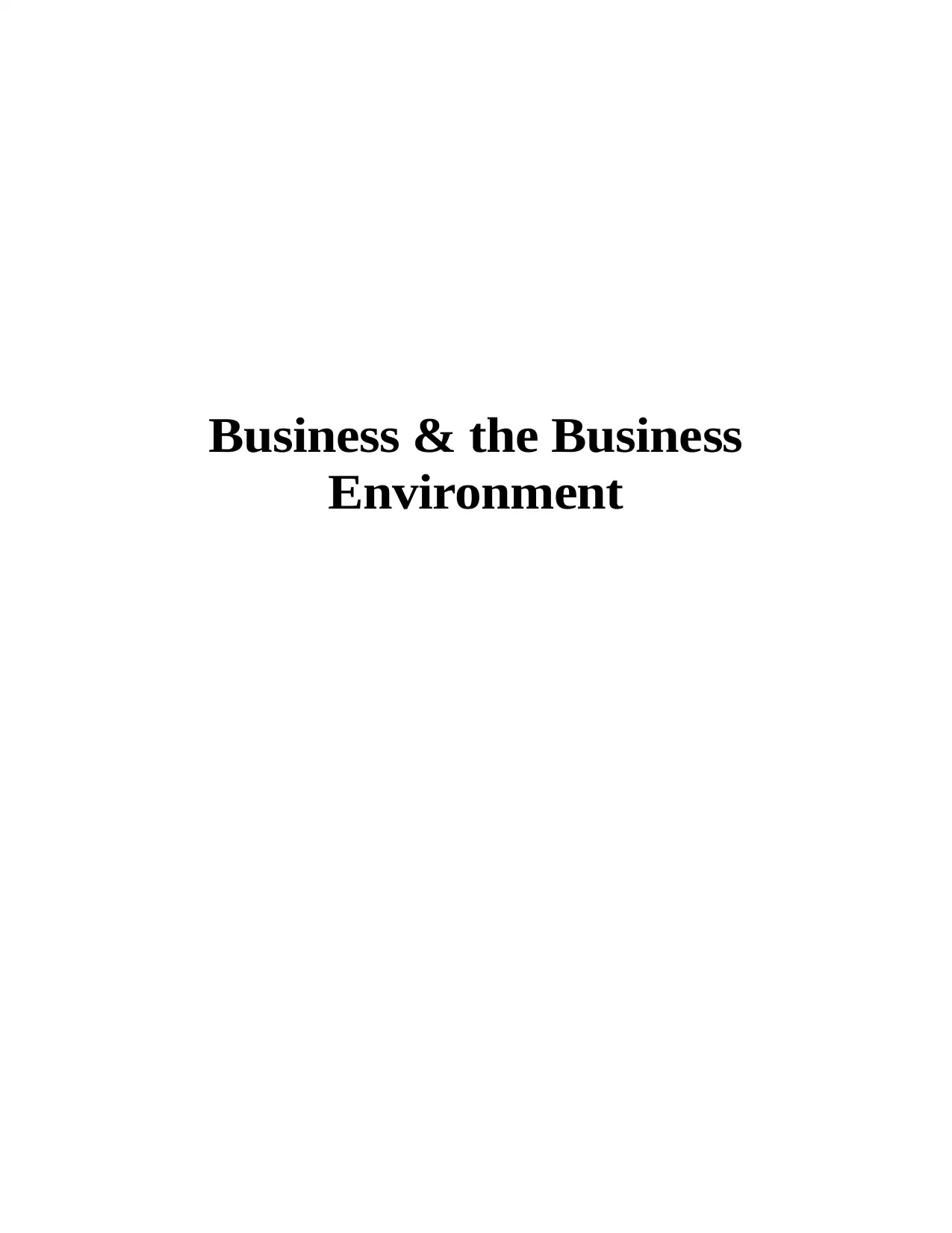
Business & the Business
Environment
Environment
Paraphrase This Document
Need a fresh take? Get an instant paraphrase of this document with our AI Paraphraser
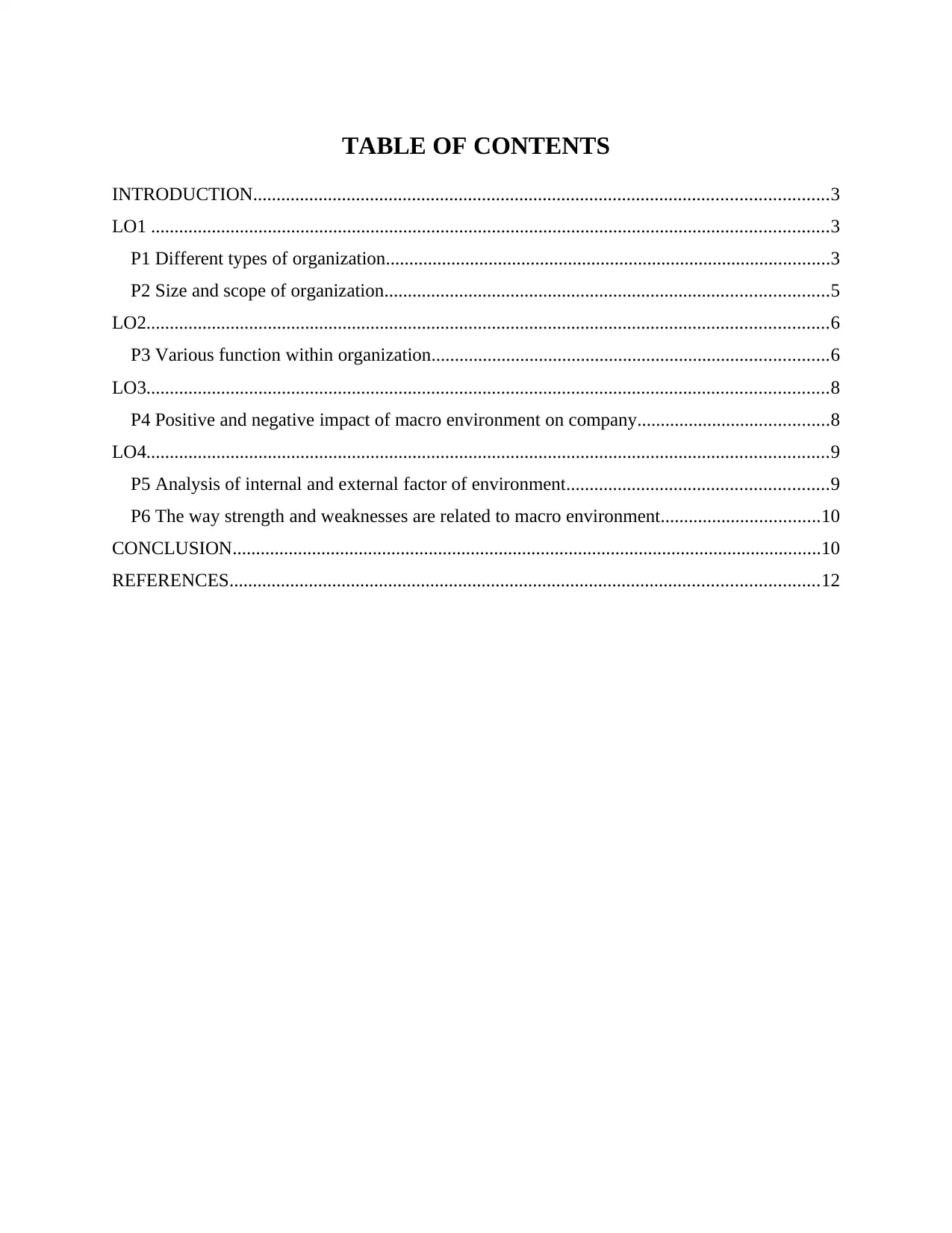
TABLE OF CONTENTS
INTRODUCTION...........................................................................................................................3
LO1 .................................................................................................................................................3
P1 Different types of organization...............................................................................................3
P2 Size and scope of organization...............................................................................................5
LO2..................................................................................................................................................6
P3 Various function within organization.....................................................................................6
LO3..................................................................................................................................................8
P4 Positive and negative impact of macro environment on company.........................................8
LO4..................................................................................................................................................9
P5 Analysis of internal and external factor of environment........................................................9
P6 The way strength and weaknesses are related to macro environment..................................10
CONCLUSION..............................................................................................................................10
REFERENCES..............................................................................................................................12
INTRODUCTION...........................................................................................................................3
LO1 .................................................................................................................................................3
P1 Different types of organization...............................................................................................3
P2 Size and scope of organization...............................................................................................5
LO2..................................................................................................................................................6
P3 Various function within organization.....................................................................................6
LO3..................................................................................................................................................8
P4 Positive and negative impact of macro environment on company.........................................8
LO4..................................................................................................................................................9
P5 Analysis of internal and external factor of environment........................................................9
P6 The way strength and weaknesses are related to macro environment..................................10
CONCLUSION..............................................................................................................................10
REFERENCES..............................................................................................................................12
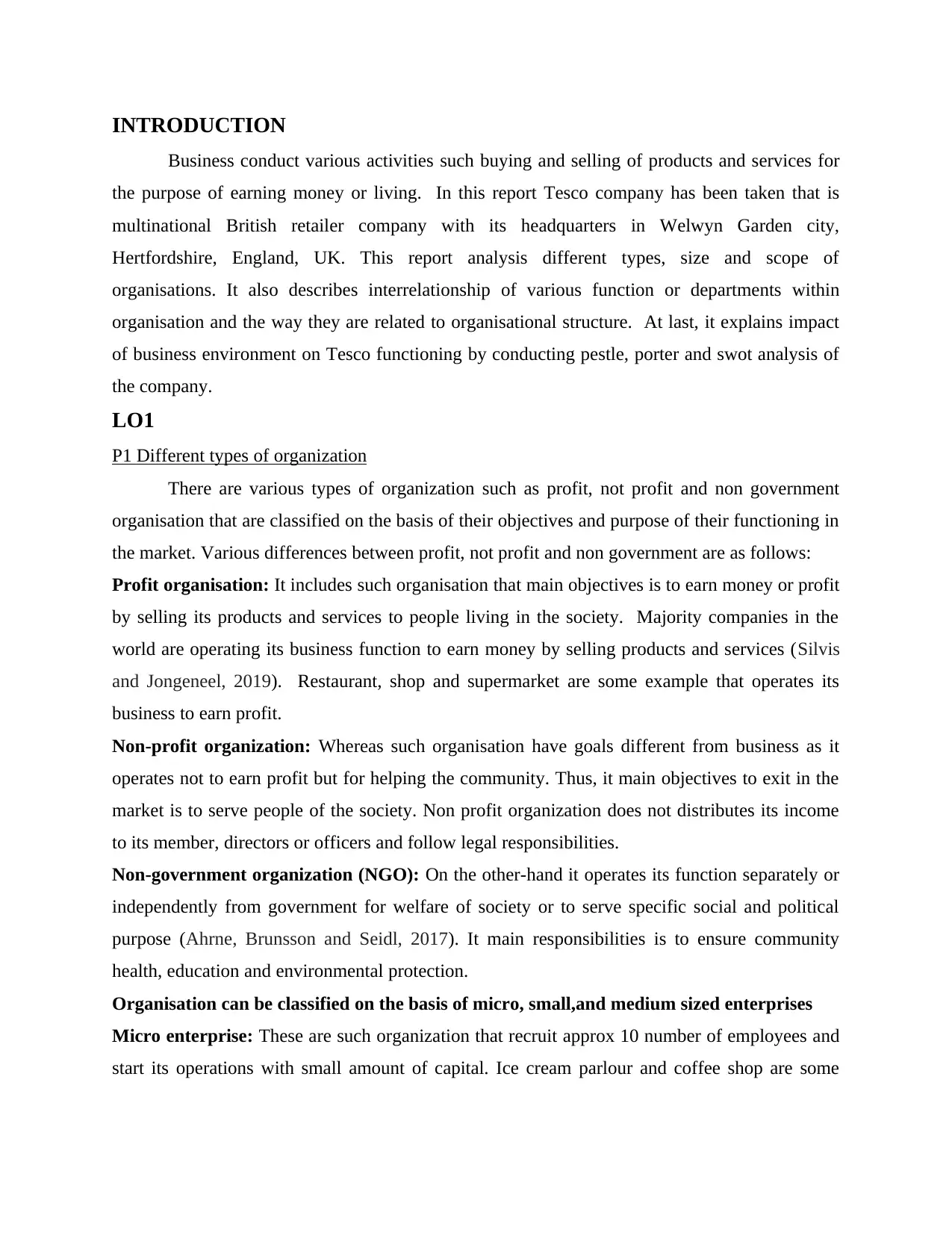
INTRODUCTION
Business conduct various activities such buying and selling of products and services for
the purpose of earning money or living. In this report Tesco company has been taken that is
multinational British retailer company with its headquarters in Welwyn Garden city,
Hertfordshire, England, UK. This report analysis different types, size and scope of
organisations. It also describes interrelationship of various function or departments within
organisation and the way they are related to organisational structure. At last, it explains impact
of business environment on Tesco functioning by conducting pestle, porter and swot analysis of
the company.
LO1
P1 Different types of organization
There are various types of organization such as profit, not profit and non government
organisation that are classified on the basis of their objectives and purpose of their functioning in
the market. Various differences between profit, not profit and non government are as follows:
Profit organisation: It includes such organisation that main objectives is to earn money or profit
by selling its products and services to people living in the society. Majority companies in the
world are operating its business function to earn money by selling products and services (Silvis
and Jongeneel, 2019). Restaurant, shop and supermarket are some example that operates its
business to earn profit.
Non-profit organization: Whereas such organisation have goals different from business as it
operates not to earn profit but for helping the community. Thus, it main objectives to exit in the
market is to serve people of the society. Non profit organization does not distributes its income
to its member, directors or officers and follow legal responsibilities.
Non-government organization (NGO): On the other-hand it operates its function separately or
independently from government for welfare of society or to serve specific social and political
purpose (Ahrne, Brunsson and Seidl, 2017). It main responsibilities is to ensure community
health, education and environmental protection.
Organisation can be classified on the basis of micro, small,and medium sized enterprises
Micro enterprise: These are such organization that recruit approx 10 number of employees and
start its operations with small amount of capital. Ice cream parlour and coffee shop are some
Business conduct various activities such buying and selling of products and services for
the purpose of earning money or living. In this report Tesco company has been taken that is
multinational British retailer company with its headquarters in Welwyn Garden city,
Hertfordshire, England, UK. This report analysis different types, size and scope of
organisations. It also describes interrelationship of various function or departments within
organisation and the way they are related to organisational structure. At last, it explains impact
of business environment on Tesco functioning by conducting pestle, porter and swot analysis of
the company.
LO1
P1 Different types of organization
There are various types of organization such as profit, not profit and non government
organisation that are classified on the basis of their objectives and purpose of their functioning in
the market. Various differences between profit, not profit and non government are as follows:
Profit organisation: It includes such organisation that main objectives is to earn money or profit
by selling its products and services to people living in the society. Majority companies in the
world are operating its business function to earn money by selling products and services (Silvis
and Jongeneel, 2019). Restaurant, shop and supermarket are some example that operates its
business to earn profit.
Non-profit organization: Whereas such organisation have goals different from business as it
operates not to earn profit but for helping the community. Thus, it main objectives to exit in the
market is to serve people of the society. Non profit organization does not distributes its income
to its member, directors or officers and follow legal responsibilities.
Non-government organization (NGO): On the other-hand it operates its function separately or
independently from government for welfare of society or to serve specific social and political
purpose (Ahrne, Brunsson and Seidl, 2017). It main responsibilities is to ensure community
health, education and environmental protection.
Organisation can be classified on the basis of micro, small,and medium sized enterprises
Micro enterprise: These are such organization that recruit approx 10 number of employees and
start its operations with small amount of capital. Ice cream parlour and coffee shop are some
⊘ This is a preview!⊘
Do you want full access?
Subscribe today to unlock all pages.

Trusted by 1+ million students worldwide
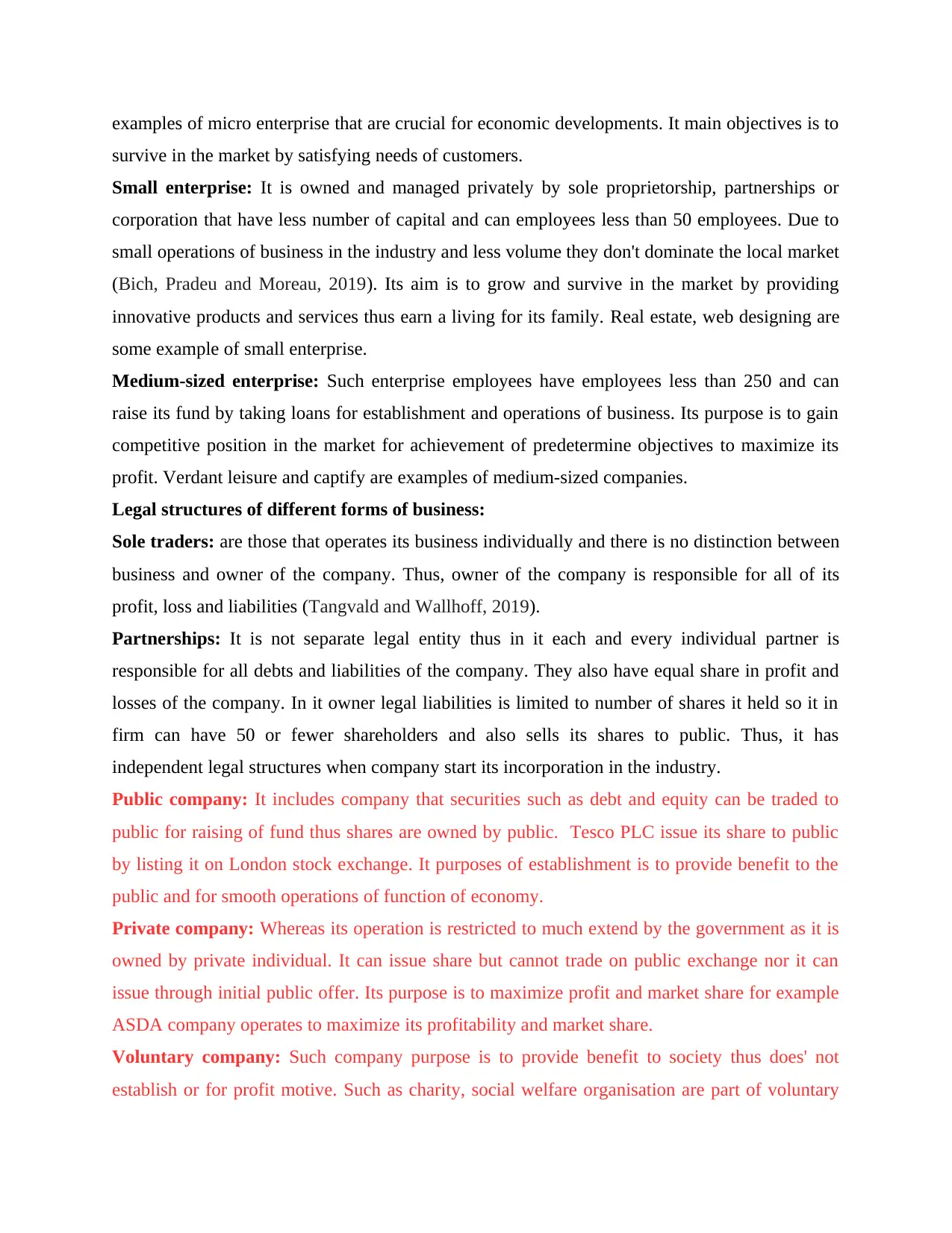
examples of micro enterprise that are crucial for economic developments. It main objectives is to
survive in the market by satisfying needs of customers.
Small enterprise: It is owned and managed privately by sole proprietorship, partnerships or
corporation that have less number of capital and can employees less than 50 employees. Due to
small operations of business in the industry and less volume they don't dominate the local market
(Bich, Pradeu and Moreau, 2019). Its aim is to grow and survive in the market by providing
innovative products and services thus earn a living for its family. Real estate, web designing are
some example of small enterprise.
Medium-sized enterprise: Such enterprise employees have employees less than 250 and can
raise its fund by taking loans for establishment and operations of business. Its purpose is to gain
competitive position in the market for achievement of predetermine objectives to maximize its
profit. Verdant leisure and captify are examples of medium-sized companies.
Legal structures of different forms of business:
Sole traders: are those that operates its business individually and there is no distinction between
business and owner of the company. Thus, owner of the company is responsible for all of its
profit, loss and liabilities (Tangvald and Wallhoff, 2019).
Partnerships: It is not separate legal entity thus in it each and every individual partner is
responsible for all debts and liabilities of the company. They also have equal share in profit and
losses of the company. In it owner legal liabilities is limited to number of shares it held so it in
firm can have 50 or fewer shareholders and also sells its shares to public. Thus, it has
independent legal structures when company start its incorporation in the industry.
Public company: It includes company that securities such as debt and equity can be traded to
public for raising of fund thus shares are owned by public. Tesco PLC issue its share to public
by listing it on London stock exchange. It purposes of establishment is to provide benefit to the
public and for smooth operations of function of economy.
Private company: Whereas its operation is restricted to much extend by the government as it is
owned by private individual. It can issue share but cannot trade on public exchange nor it can
issue through initial public offer. Its purpose is to maximize profit and market share for example
ASDA company operates to maximize its profitability and market share.
Voluntary company: Such company purpose is to provide benefit to society thus does' not
establish or for profit motive. Such as charity, social welfare organisation are part of voluntary
survive in the market by satisfying needs of customers.
Small enterprise: It is owned and managed privately by sole proprietorship, partnerships or
corporation that have less number of capital and can employees less than 50 employees. Due to
small operations of business in the industry and less volume they don't dominate the local market
(Bich, Pradeu and Moreau, 2019). Its aim is to grow and survive in the market by providing
innovative products and services thus earn a living for its family. Real estate, web designing are
some example of small enterprise.
Medium-sized enterprise: Such enterprise employees have employees less than 250 and can
raise its fund by taking loans for establishment and operations of business. Its purpose is to gain
competitive position in the market for achievement of predetermine objectives to maximize its
profit. Verdant leisure and captify are examples of medium-sized companies.
Legal structures of different forms of business:
Sole traders: are those that operates its business individually and there is no distinction between
business and owner of the company. Thus, owner of the company is responsible for all of its
profit, loss and liabilities (Tangvald and Wallhoff, 2019).
Partnerships: It is not separate legal entity thus in it each and every individual partner is
responsible for all debts and liabilities of the company. They also have equal share in profit and
losses of the company. In it owner legal liabilities is limited to number of shares it held so it in
firm can have 50 or fewer shareholders and also sells its shares to public. Thus, it has
independent legal structures when company start its incorporation in the industry.
Public company: It includes company that securities such as debt and equity can be traded to
public for raising of fund thus shares are owned by public. Tesco PLC issue its share to public
by listing it on London stock exchange. It purposes of establishment is to provide benefit to the
public and for smooth operations of function of economy.
Private company: Whereas its operation is restricted to much extend by the government as it is
owned by private individual. It can issue share but cannot trade on public exchange nor it can
issue through initial public offer. Its purpose is to maximize profit and market share for example
ASDA company operates to maximize its profitability and market share.
Voluntary company: Such company purpose is to provide benefit to society thus does' not
establish or for profit motive. Such as charity, social welfare organisation are part of voluntary
Paraphrase This Document
Need a fresh take? Get an instant paraphrase of this document with our AI Paraphraser
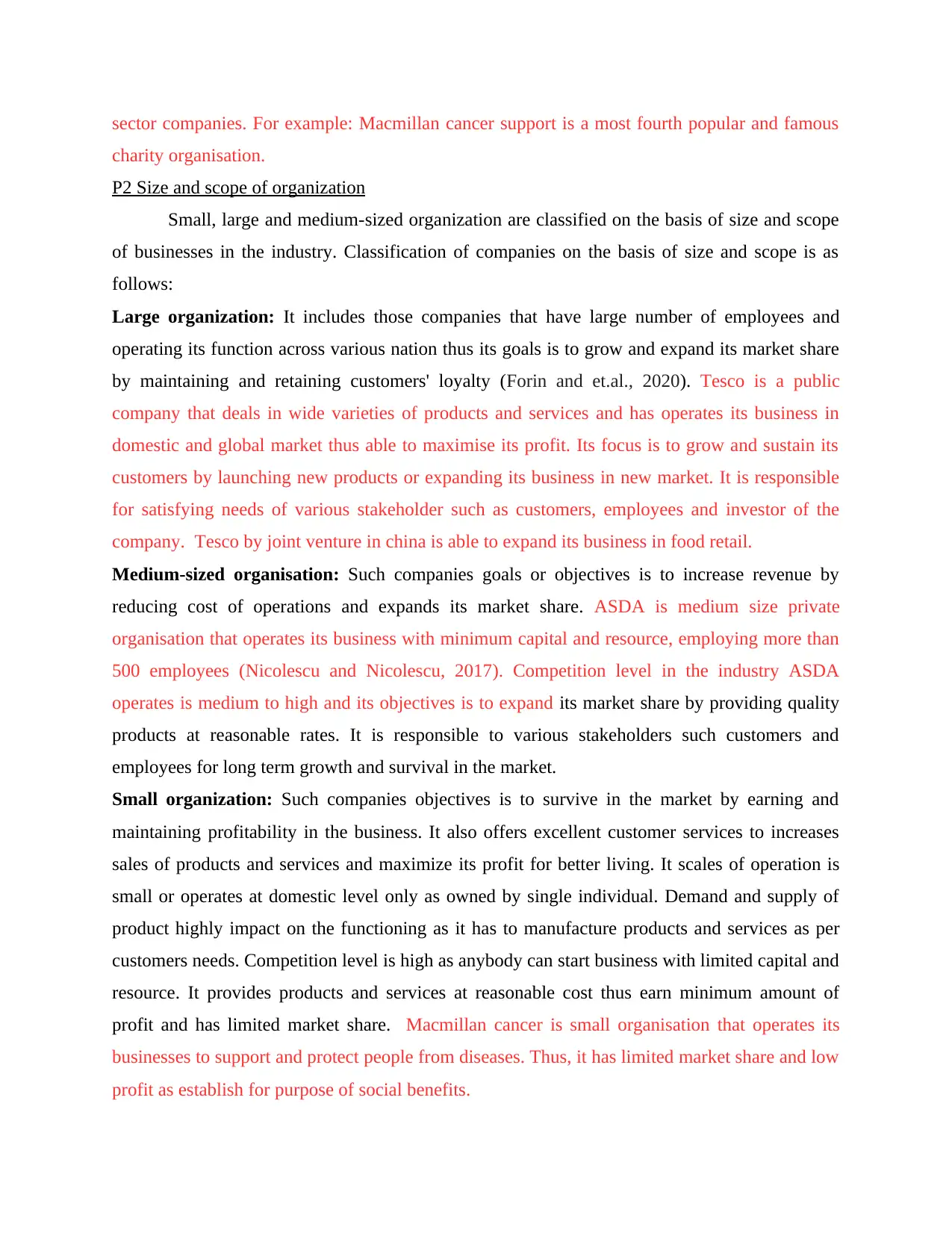
sector companies. For example: Macmillan cancer support is a most fourth popular and famous
charity organisation.
P2 Size and scope of organization
Small, large and medium-sized organization are classified on the basis of size and scope
of businesses in the industry. Classification of companies on the basis of size and scope is as
follows:
Large organization: It includes those companies that have large number of employees and
operating its function across various nation thus its goals is to grow and expand its market share
by maintaining and retaining customers' loyalty (Forin and et.al., 2020). Tesco is a public
company that deals in wide varieties of products and services and has operates its business in
domestic and global market thus able to maximise its profit. Its focus is to grow and sustain its
customers by launching new products or expanding its business in new market. It is responsible
for satisfying needs of various stakeholder such as customers, employees and investor of the
company. Tesco by joint venture in china is able to expand its business in food retail.
Medium-sized organisation: Such companies goals or objectives is to increase revenue by
reducing cost of operations and expands its market share. ASDA is medium size private
organisation that operates its business with minimum capital and resource, employing more than
500 employees (Nicolescu and Nicolescu, 2017). Competition level in the industry ASDA
operates is medium to high and its objectives is to expand its market share by providing quality
products at reasonable rates. It is responsible to various stakeholders such customers and
employees for long term growth and survival in the market.
Small organization: Such companies objectives is to survive in the market by earning and
maintaining profitability in the business. It also offers excellent customer services to increases
sales of products and services and maximize its profit for better living. It scales of operation is
small or operates at domestic level only as owned by single individual. Demand and supply of
product highly impact on the functioning as it has to manufacture products and services as per
customers needs. Competition level is high as anybody can start business with limited capital and
resource. It provides products and services at reasonable cost thus earn minimum amount of
profit and has limited market share. Macmillan cancer is small organisation that operates its
businesses to support and protect people from diseases. Thus, it has limited market share and low
profit as establish for purpose of social benefits.
charity organisation.
P2 Size and scope of organization
Small, large and medium-sized organization are classified on the basis of size and scope
of businesses in the industry. Classification of companies on the basis of size and scope is as
follows:
Large organization: It includes those companies that have large number of employees and
operating its function across various nation thus its goals is to grow and expand its market share
by maintaining and retaining customers' loyalty (Forin and et.al., 2020). Tesco is a public
company that deals in wide varieties of products and services and has operates its business in
domestic and global market thus able to maximise its profit. Its focus is to grow and sustain its
customers by launching new products or expanding its business in new market. It is responsible
for satisfying needs of various stakeholder such as customers, employees and investor of the
company. Tesco by joint venture in china is able to expand its business in food retail.
Medium-sized organisation: Such companies goals or objectives is to increase revenue by
reducing cost of operations and expands its market share. ASDA is medium size private
organisation that operates its business with minimum capital and resource, employing more than
500 employees (Nicolescu and Nicolescu, 2017). Competition level in the industry ASDA
operates is medium to high and its objectives is to expand its market share by providing quality
products at reasonable rates. It is responsible to various stakeholders such customers and
employees for long term growth and survival in the market.
Small organization: Such companies objectives is to survive in the market by earning and
maintaining profitability in the business. It also offers excellent customer services to increases
sales of products and services and maximize its profit for better living. It scales of operation is
small or operates at domestic level only as owned by single individual. Demand and supply of
product highly impact on the functioning as it has to manufacture products and services as per
customers needs. Competition level is high as anybody can start business with limited capital and
resource. It provides products and services at reasonable cost thus earn minimum amount of
profit and has limited market share. Macmillan cancer is small organisation that operates its
businesses to support and protect people from diseases. Thus, it has limited market share and low
profit as establish for purpose of social benefits.
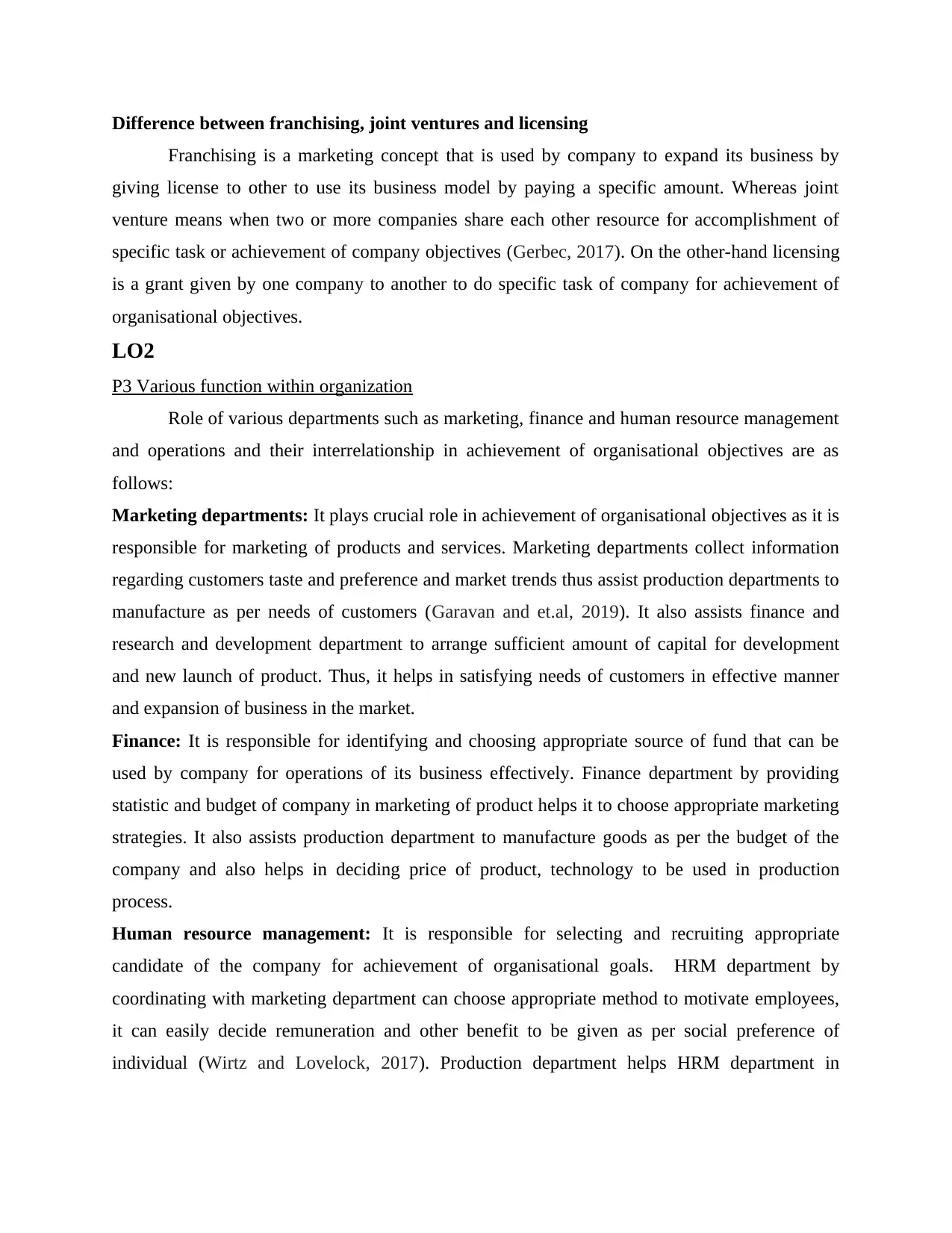
Difference between franchising, joint ventures and licensing
Franchising is a marketing concept that is used by company to expand its business by
giving license to other to use its business model by paying a specific amount. Whereas joint
venture means when two or more companies share each other resource for accomplishment of
specific task or achievement of company objectives (Gerbec, 2017). On the other-hand licensing
is a grant given by one company to another to do specific task of company for achievement of
organisational objectives.
LO2
P3 Various function within organization
Role of various departments such as marketing, finance and human resource management
and operations and their interrelationship in achievement of organisational objectives are as
follows:
Marketing departments: It plays crucial role in achievement of organisational objectives as it is
responsible for marketing of products and services. Marketing departments collect information
regarding customers taste and preference and market trends thus assist production departments to
manufacture as per needs of customers (Garavan and et.al, 2019). It also assists finance and
research and development department to arrange sufficient amount of capital for development
and new launch of product. Thus, it helps in satisfying needs of customers in effective manner
and expansion of business in the market.
Finance: It is responsible for identifying and choosing appropriate source of fund that can be
used by company for operations of its business effectively. Finance department by providing
statistic and budget of company in marketing of product helps it to choose appropriate marketing
strategies. It also assists production department to manufacture goods as per the budget of the
company and also helps in deciding price of product, technology to be used in production
process.
Human resource management: It is responsible for selecting and recruiting appropriate
candidate of the company for achievement of organisational goals. HRM department by
coordinating with marketing department can choose appropriate method to motivate employees,
it can easily decide remuneration and other benefit to be given as per social preference of
individual (Wirtz and Lovelock, 2017). Production department helps HRM department in
Franchising is a marketing concept that is used by company to expand its business by
giving license to other to use its business model by paying a specific amount. Whereas joint
venture means when two or more companies share each other resource for accomplishment of
specific task or achievement of company objectives (Gerbec, 2017). On the other-hand licensing
is a grant given by one company to another to do specific task of company for achievement of
organisational objectives.
LO2
P3 Various function within organization
Role of various departments such as marketing, finance and human resource management
and operations and their interrelationship in achievement of organisational objectives are as
follows:
Marketing departments: It plays crucial role in achievement of organisational objectives as it is
responsible for marketing of products and services. Marketing departments collect information
regarding customers taste and preference and market trends thus assist production departments to
manufacture as per needs of customers (Garavan and et.al, 2019). It also assists finance and
research and development department to arrange sufficient amount of capital for development
and new launch of product. Thus, it helps in satisfying needs of customers in effective manner
and expansion of business in the market.
Finance: It is responsible for identifying and choosing appropriate source of fund that can be
used by company for operations of its business effectively. Finance department by providing
statistic and budget of company in marketing of product helps it to choose appropriate marketing
strategies. It also assists production department to manufacture goods as per the budget of the
company and also helps in deciding price of product, technology to be used in production
process.
Human resource management: It is responsible for selecting and recruiting appropriate
candidate of the company for achievement of organisational goals. HRM department by
coordinating with marketing department can choose appropriate method to motivate employees,
it can easily decide remuneration and other benefit to be given as per social preference of
individual (Wirtz and Lovelock, 2017). Production department helps HRM department in
⊘ This is a preview!⊘
Do you want full access?
Subscribe today to unlock all pages.

Trusted by 1+ million students worldwide
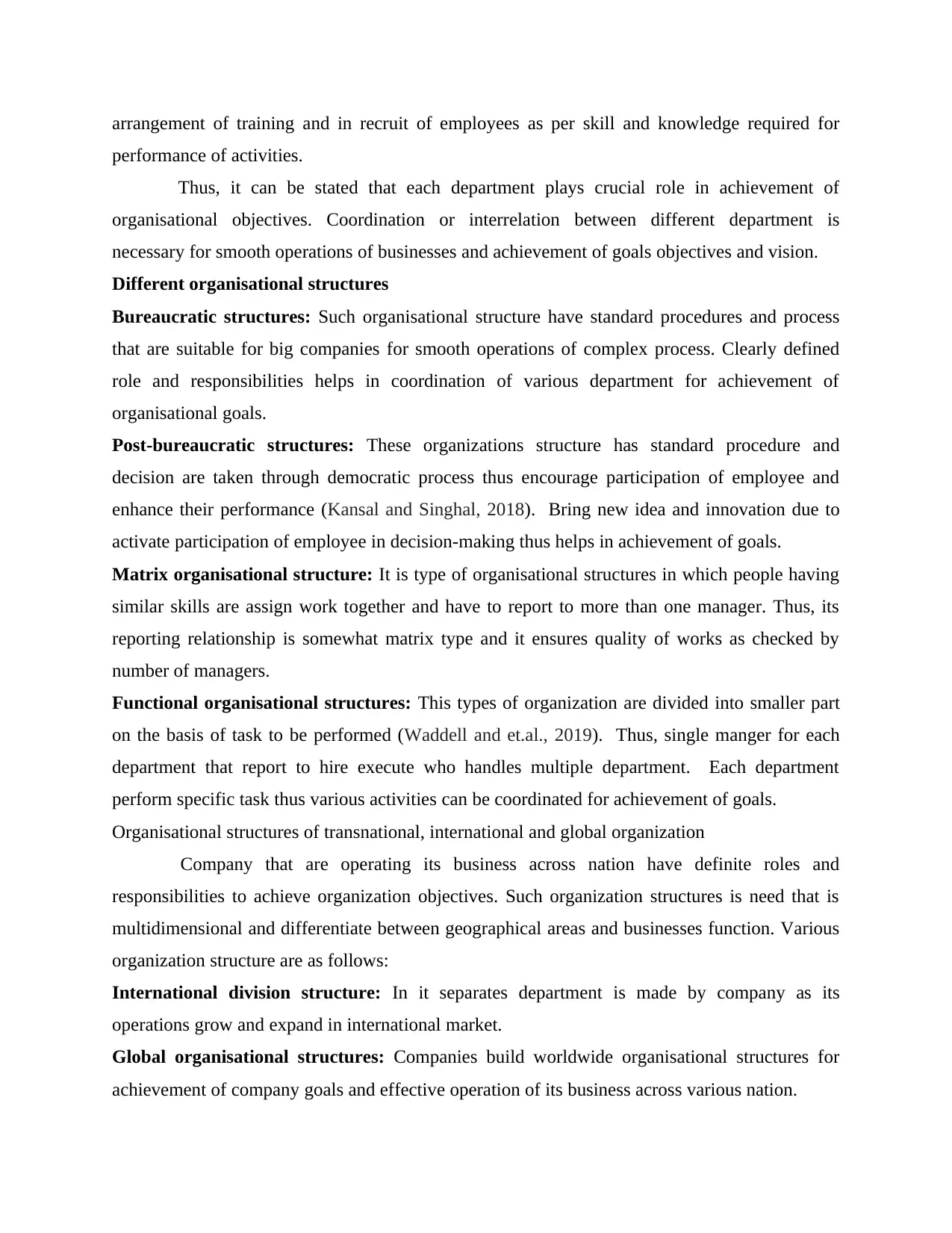
arrangement of training and in recruit of employees as per skill and knowledge required for
performance of activities.
Thus, it can be stated that each department plays crucial role in achievement of
organisational objectives. Coordination or interrelation between different department is
necessary for smooth operations of businesses and achievement of goals objectives and vision.
Different organisational structures
Bureaucratic structures: Such organisational structure have standard procedures and process
that are suitable for big companies for smooth operations of complex process. Clearly defined
role and responsibilities helps in coordination of various department for achievement of
organisational goals.
Post-bureaucratic structures: These organizations structure has standard procedure and
decision are taken through democratic process thus encourage participation of employee and
enhance their performance (Kansal and Singhal, 2018). Bring new idea and innovation due to
activate participation of employee in decision-making thus helps in achievement of goals.
Matrix organisational structure: It is type of organisational structures in which people having
similar skills are assign work together and have to report to more than one manager. Thus, its
reporting relationship is somewhat matrix type and it ensures quality of works as checked by
number of managers.
Functional organisational structures: This types of organization are divided into smaller part
on the basis of task to be performed (Waddell and et.al., 2019). Thus, single manger for each
department that report to hire execute who handles multiple department. Each department
perform specific task thus various activities can be coordinated for achievement of goals.
Organisational structures of transnational, international and global organization
Company that are operating its business across nation have definite roles and
responsibilities to achieve organization objectives. Such organization structures is need that is
multidimensional and differentiate between geographical areas and businesses function. Various
organization structure are as follows:
International division structure: In it separates department is made by company as its
operations grow and expand in international market.
Global organisational structures: Companies build worldwide organisational structures for
achievement of company goals and effective operation of its business across various nation.
performance of activities.
Thus, it can be stated that each department plays crucial role in achievement of
organisational objectives. Coordination or interrelation between different department is
necessary for smooth operations of businesses and achievement of goals objectives and vision.
Different organisational structures
Bureaucratic structures: Such organisational structure have standard procedures and process
that are suitable for big companies for smooth operations of complex process. Clearly defined
role and responsibilities helps in coordination of various department for achievement of
organisational goals.
Post-bureaucratic structures: These organizations structure has standard procedure and
decision are taken through democratic process thus encourage participation of employee and
enhance their performance (Kansal and Singhal, 2018). Bring new idea and innovation due to
activate participation of employee in decision-making thus helps in achievement of goals.
Matrix organisational structure: It is type of organisational structures in which people having
similar skills are assign work together and have to report to more than one manager. Thus, its
reporting relationship is somewhat matrix type and it ensures quality of works as checked by
number of managers.
Functional organisational structures: This types of organization are divided into smaller part
on the basis of task to be performed (Waddell and et.al., 2019). Thus, single manger for each
department that report to hire execute who handles multiple department. Each department
perform specific task thus various activities can be coordinated for achievement of goals.
Organisational structures of transnational, international and global organization
Company that are operating its business across nation have definite roles and
responsibilities to achieve organization objectives. Such organization structures is need that is
multidimensional and differentiate between geographical areas and businesses function. Various
organization structure are as follows:
International division structure: In it separates department is made by company as its
operations grow and expand in international market.
Global organisational structures: Companies build worldwide organisational structures for
achievement of company goals and effective operation of its business across various nation.
Paraphrase This Document
Need a fresh take? Get an instant paraphrase of this document with our AI Paraphraser
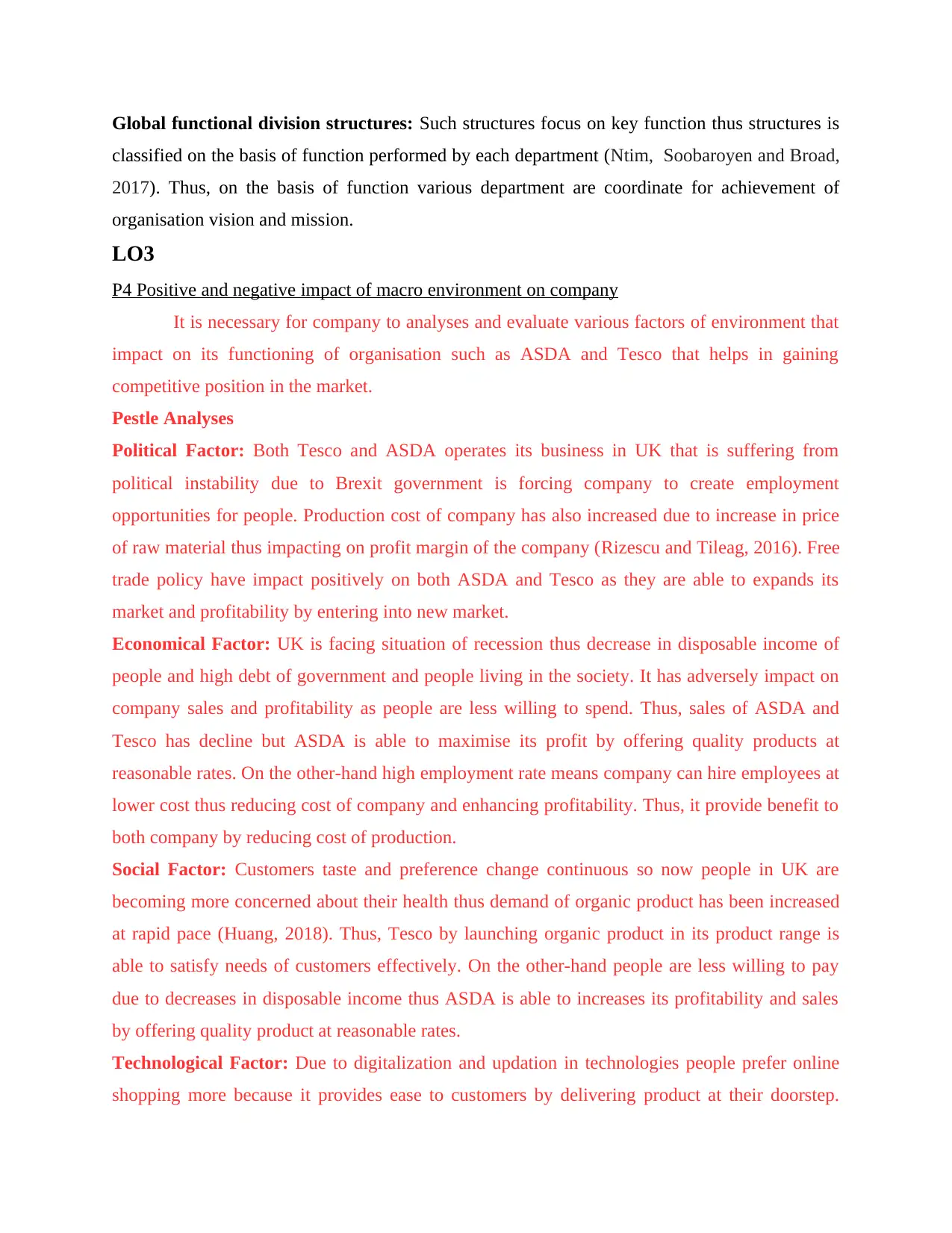
Global functional division structures: Such structures focus on key function thus structures is
classified on the basis of function performed by each department (Ntim, Soobaroyen and Broad,
2017). Thus, on the basis of function various department are coordinate for achievement of
organisation vision and mission.
LO3
P4 Positive and negative impact of macro environment on company
It is necessary for company to analyses and evaluate various factors of environment that
impact on its functioning of organisation such as ASDA and Tesco that helps in gaining
competitive position in the market.
Pestle Analyses
Political Factor: Both Tesco and ASDA operates its business in UK that is suffering from
political instability due to Brexit government is forcing company to create employment
opportunities for people. Production cost of company has also increased due to increase in price
of raw material thus impacting on profit margin of the company (Rizescu and Tileag, 2016). Free
trade policy have impact positively on both ASDA and Tesco as they are able to expands its
market and profitability by entering into new market.
Economical Factor: UK is facing situation of recession thus decrease in disposable income of
people and high debt of government and people living in the society. It has adversely impact on
company sales and profitability as people are less willing to spend. Thus, sales of ASDA and
Tesco has decline but ASDA is able to maximise its profit by offering quality products at
reasonable rates. On the other-hand high employment rate means company can hire employees at
lower cost thus reducing cost of company and enhancing profitability. Thus, it provide benefit to
both company by reducing cost of production.
Social Factor: Customers taste and preference change continuous so now people in UK are
becoming more concerned about their health thus demand of organic product has been increased
at rapid pace (Huang, 2018). Thus, Tesco by launching organic product in its product range is
able to satisfy needs of customers effectively. On the other-hand people are less willing to pay
due to decreases in disposable income thus ASDA is able to increases its profitability and sales
by offering quality product at reasonable rates.
Technological Factor: Due to digitalization and updation in technologies people prefer online
shopping more because it provides ease to customers by delivering product at their doorstep.
classified on the basis of function performed by each department (Ntim, Soobaroyen and Broad,
2017). Thus, on the basis of function various department are coordinate for achievement of
organisation vision and mission.
LO3
P4 Positive and negative impact of macro environment on company
It is necessary for company to analyses and evaluate various factors of environment that
impact on its functioning of organisation such as ASDA and Tesco that helps in gaining
competitive position in the market.
Pestle Analyses
Political Factor: Both Tesco and ASDA operates its business in UK that is suffering from
political instability due to Brexit government is forcing company to create employment
opportunities for people. Production cost of company has also increased due to increase in price
of raw material thus impacting on profit margin of the company (Rizescu and Tileag, 2016). Free
trade policy have impact positively on both ASDA and Tesco as they are able to expands its
market and profitability by entering into new market.
Economical Factor: UK is facing situation of recession thus decrease in disposable income of
people and high debt of government and people living in the society. It has adversely impact on
company sales and profitability as people are less willing to spend. Thus, sales of ASDA and
Tesco has decline but ASDA is able to maximise its profit by offering quality products at
reasonable rates. On the other-hand high employment rate means company can hire employees at
lower cost thus reducing cost of company and enhancing profitability. Thus, it provide benefit to
both company by reducing cost of production.
Social Factor: Customers taste and preference change continuous so now people in UK are
becoming more concerned about their health thus demand of organic product has been increased
at rapid pace (Huang, 2018). Thus, Tesco by launching organic product in its product range is
able to satisfy needs of customers effectively. On the other-hand people are less willing to pay
due to decreases in disposable income thus ASDA is able to increases its profitability and sales
by offering quality product at reasonable rates.
Technological Factor: Due to digitalization and updation in technologies people prefer online
shopping more because it provides ease to customers by delivering product at their doorstep.
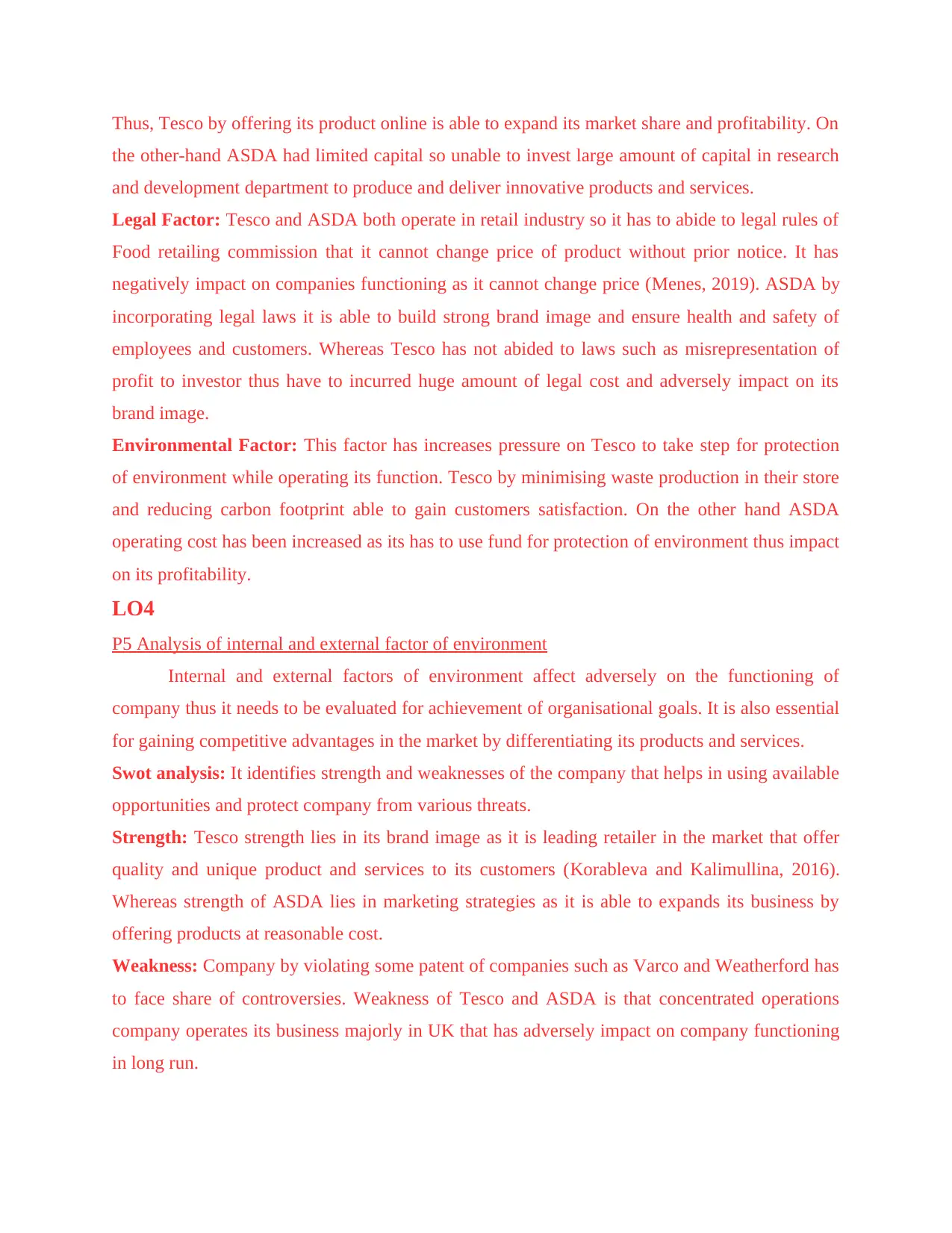
Thus, Tesco by offering its product online is able to expand its market share and profitability. On
the other-hand ASDA had limited capital so unable to invest large amount of capital in research
and development department to produce and deliver innovative products and services.
Legal Factor: Tesco and ASDA both operate in retail industry so it has to abide to legal rules of
Food retailing commission that it cannot change price of product without prior notice. It has
negatively impact on companies functioning as it cannot change price (Menes, 2019). ASDA by
incorporating legal laws it is able to build strong brand image and ensure health and safety of
employees and customers. Whereas Tesco has not abided to laws such as misrepresentation of
profit to investor thus have to incurred huge amount of legal cost and adversely impact on its
brand image.
Environmental Factor: This factor has increases pressure on Tesco to take step for protection
of environment while operating its function. Tesco by minimising waste production in their store
and reducing carbon footprint able to gain customers satisfaction. On the other hand ASDA
operating cost has been increased as its has to use fund for protection of environment thus impact
on its profitability.
LO4
P5 Analysis of internal and external factor of environment
Internal and external factors of environment affect adversely on the functioning of
company thus it needs to be evaluated for achievement of organisational goals. It is also essential
for gaining competitive advantages in the market by differentiating its products and services.
Swot analysis: It identifies strength and weaknesses of the company that helps in using available
opportunities and protect company from various threats.
Strength: Tesco strength lies in its brand image as it is leading retailer in the market that offer
quality and unique product and services to its customers (Korableva and Kalimullina, 2016).
Whereas strength of ASDA lies in marketing strategies as it is able to expands its business by
offering products at reasonable cost.
Weakness: Company by violating some patent of companies such as Varco and Weatherford has
to face share of controversies. Weakness of Tesco and ASDA is that concentrated operations
company operates its business majorly in UK that has adversely impact on company functioning
in long run.
the other-hand ASDA had limited capital so unable to invest large amount of capital in research
and development department to produce and deliver innovative products and services.
Legal Factor: Tesco and ASDA both operate in retail industry so it has to abide to legal rules of
Food retailing commission that it cannot change price of product without prior notice. It has
negatively impact on companies functioning as it cannot change price (Menes, 2019). ASDA by
incorporating legal laws it is able to build strong brand image and ensure health and safety of
employees and customers. Whereas Tesco has not abided to laws such as misrepresentation of
profit to investor thus have to incurred huge amount of legal cost and adversely impact on its
brand image.
Environmental Factor: This factor has increases pressure on Tesco to take step for protection
of environment while operating its function. Tesco by minimising waste production in their store
and reducing carbon footprint able to gain customers satisfaction. On the other hand ASDA
operating cost has been increased as its has to use fund for protection of environment thus impact
on its profitability.
LO4
P5 Analysis of internal and external factor of environment
Internal and external factors of environment affect adversely on the functioning of
company thus it needs to be evaluated for achievement of organisational goals. It is also essential
for gaining competitive advantages in the market by differentiating its products and services.
Swot analysis: It identifies strength and weaknesses of the company that helps in using available
opportunities and protect company from various threats.
Strength: Tesco strength lies in its brand image as it is leading retailer in the market that offer
quality and unique product and services to its customers (Korableva and Kalimullina, 2016).
Whereas strength of ASDA lies in marketing strategies as it is able to expands its business by
offering products at reasonable cost.
Weakness: Company by violating some patent of companies such as Varco and Weatherford has
to face share of controversies. Weakness of Tesco and ASDA is that concentrated operations
company operates its business majorly in UK that has adversely impact on company functioning
in long run.
⊘ This is a preview!⊘
Do you want full access?
Subscribe today to unlock all pages.

Trusted by 1+ million students worldwide
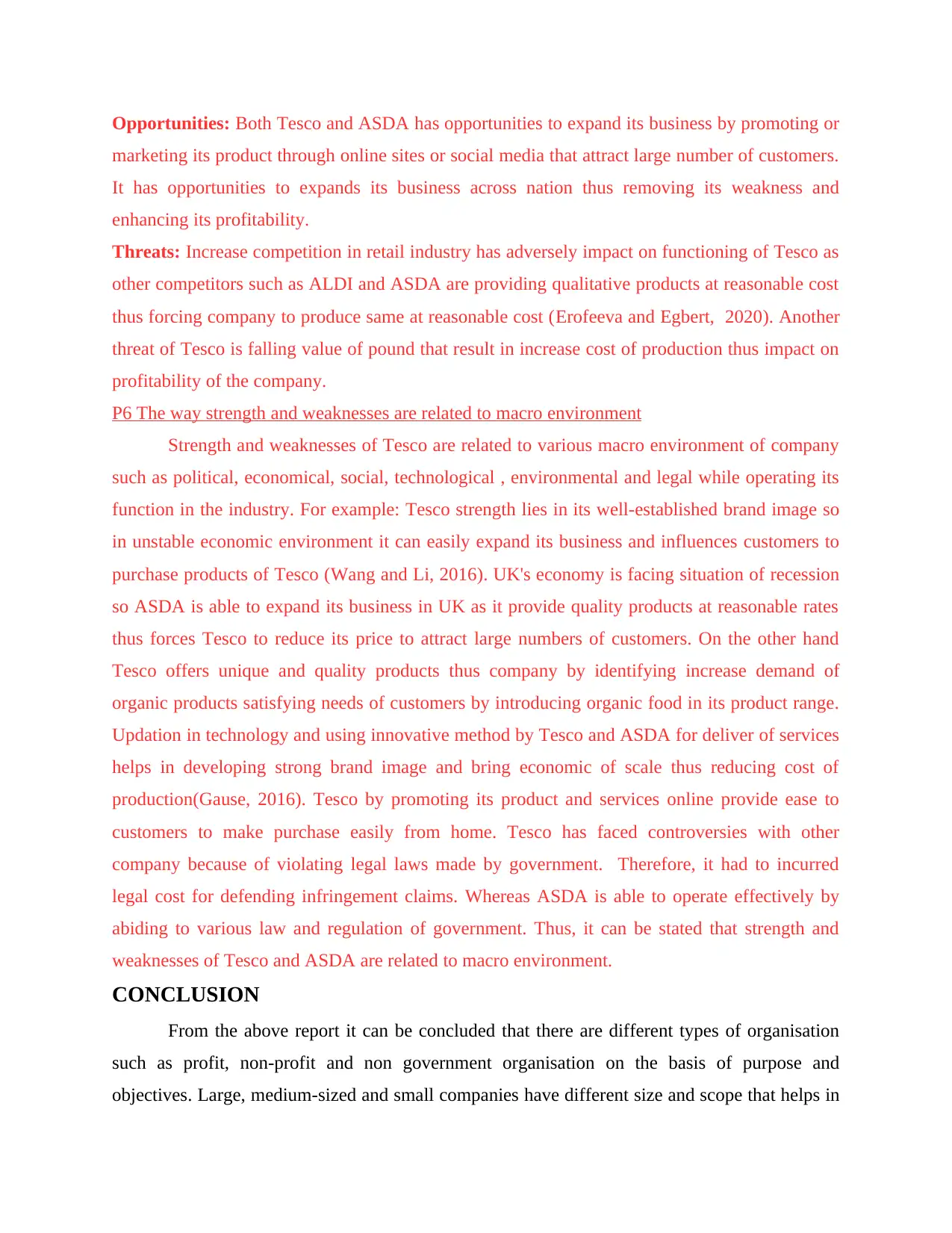
Opportunities: Both Tesco and ASDA has opportunities to expand its business by promoting or
marketing its product through online sites or social media that attract large number of customers.
It has opportunities to expands its business across nation thus removing its weakness and
enhancing its profitability.
Threats: Increase competition in retail industry has adversely impact on functioning of Tesco as
other competitors such as ALDI and ASDA are providing qualitative products at reasonable cost
thus forcing company to produce same at reasonable cost (Erofeeva and Egbert, 2020). Another
threat of Tesco is falling value of pound that result in increase cost of production thus impact on
profitability of the company.
P6 The way strength and weaknesses are related to macro environment
Strength and weaknesses of Tesco are related to various macro environment of company
such as political, economical, social, technological , environmental and legal while operating its
function in the industry. For example: Tesco strength lies in its well-established brand image so
in unstable economic environment it can easily expand its business and influences customers to
purchase products of Tesco (Wang and Li, 2016). UK's economy is facing situation of recession
so ASDA is able to expand its business in UK as it provide quality products at reasonable rates
thus forces Tesco to reduce its price to attract large numbers of customers. On the other hand
Tesco offers unique and quality products thus company by identifying increase demand of
organic products satisfying needs of customers by introducing organic food in its product range.
Updation in technology and using innovative method by Tesco and ASDA for deliver of services
helps in developing strong brand image and bring economic of scale thus reducing cost of
production(Gause, 2016). Tesco by promoting its product and services online provide ease to
customers to make purchase easily from home. Tesco has faced controversies with other
company because of violating legal laws made by government. Therefore, it had to incurred
legal cost for defending infringement claims. Whereas ASDA is able to operate effectively by
abiding to various law and regulation of government. Thus, it can be stated that strength and
weaknesses of Tesco and ASDA are related to macro environment.
CONCLUSION
From the above report it can be concluded that there are different types of organisation
such as profit, non-profit and non government organisation on the basis of purpose and
objectives. Large, medium-sized and small companies have different size and scope that helps in
marketing its product through online sites or social media that attract large number of customers.
It has opportunities to expands its business across nation thus removing its weakness and
enhancing its profitability.
Threats: Increase competition in retail industry has adversely impact on functioning of Tesco as
other competitors such as ALDI and ASDA are providing qualitative products at reasonable cost
thus forcing company to produce same at reasonable cost (Erofeeva and Egbert, 2020). Another
threat of Tesco is falling value of pound that result in increase cost of production thus impact on
profitability of the company.
P6 The way strength and weaknesses are related to macro environment
Strength and weaknesses of Tesco are related to various macro environment of company
such as political, economical, social, technological , environmental and legal while operating its
function in the industry. For example: Tesco strength lies in its well-established brand image so
in unstable economic environment it can easily expand its business and influences customers to
purchase products of Tesco (Wang and Li, 2016). UK's economy is facing situation of recession
so ASDA is able to expand its business in UK as it provide quality products at reasonable rates
thus forces Tesco to reduce its price to attract large numbers of customers. On the other hand
Tesco offers unique and quality products thus company by identifying increase demand of
organic products satisfying needs of customers by introducing organic food in its product range.
Updation in technology and using innovative method by Tesco and ASDA for deliver of services
helps in developing strong brand image and bring economic of scale thus reducing cost of
production(Gause, 2016). Tesco by promoting its product and services online provide ease to
customers to make purchase easily from home. Tesco has faced controversies with other
company because of violating legal laws made by government. Therefore, it had to incurred
legal cost for defending infringement claims. Whereas ASDA is able to operate effectively by
abiding to various law and regulation of government. Thus, it can be stated that strength and
weaknesses of Tesco and ASDA are related to macro environment.
CONCLUSION
From the above report it can be concluded that there are different types of organisation
such as profit, non-profit and non government organisation on the basis of purpose and
objectives. Large, medium-sized and small companies have different size and scope that helps in
Paraphrase This Document
Need a fresh take? Get an instant paraphrase of this document with our AI Paraphraser
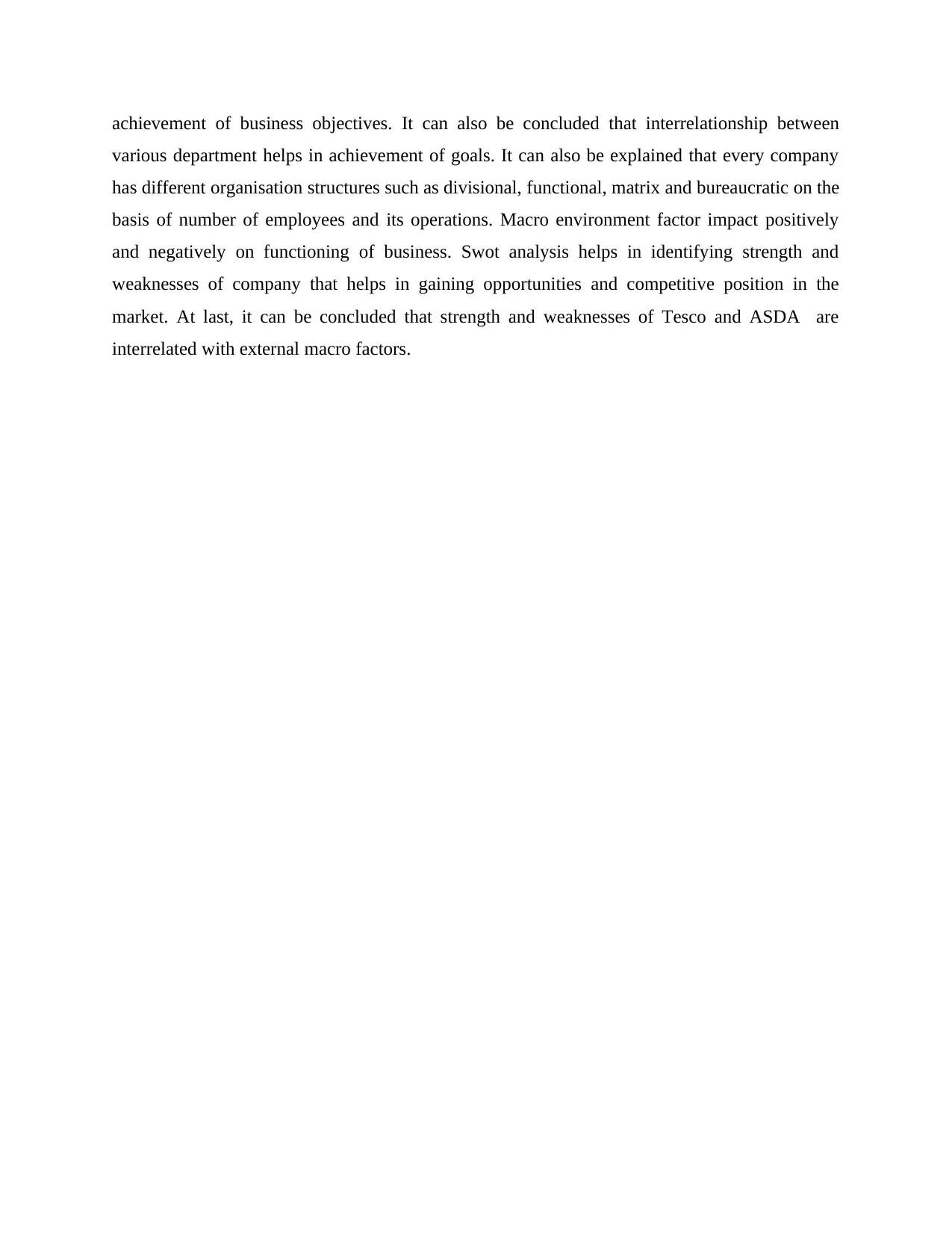
achievement of business objectives. It can also be concluded that interrelationship between
various department helps in achievement of goals. It can also be explained that every company
has different organisation structures such as divisional, functional, matrix and bureaucratic on the
basis of number of employees and its operations. Macro environment factor impact positively
and negatively on functioning of business. Swot analysis helps in identifying strength and
weaknesses of company that helps in gaining opportunities and competitive position in the
market. At last, it can be concluded that strength and weaknesses of Tesco and ASDA are
interrelated with external macro factors.
various department helps in achievement of goals. It can also be explained that every company
has different organisation structures such as divisional, functional, matrix and bureaucratic on the
basis of number of employees and its operations. Macro environment factor impact positively
and negatively on functioning of business. Swot analysis helps in identifying strength and
weaknesses of company that helps in gaining opportunities and competitive position in the
market. At last, it can be concluded that strength and weaknesses of Tesco and ASDA are
interrelated with external macro factors.
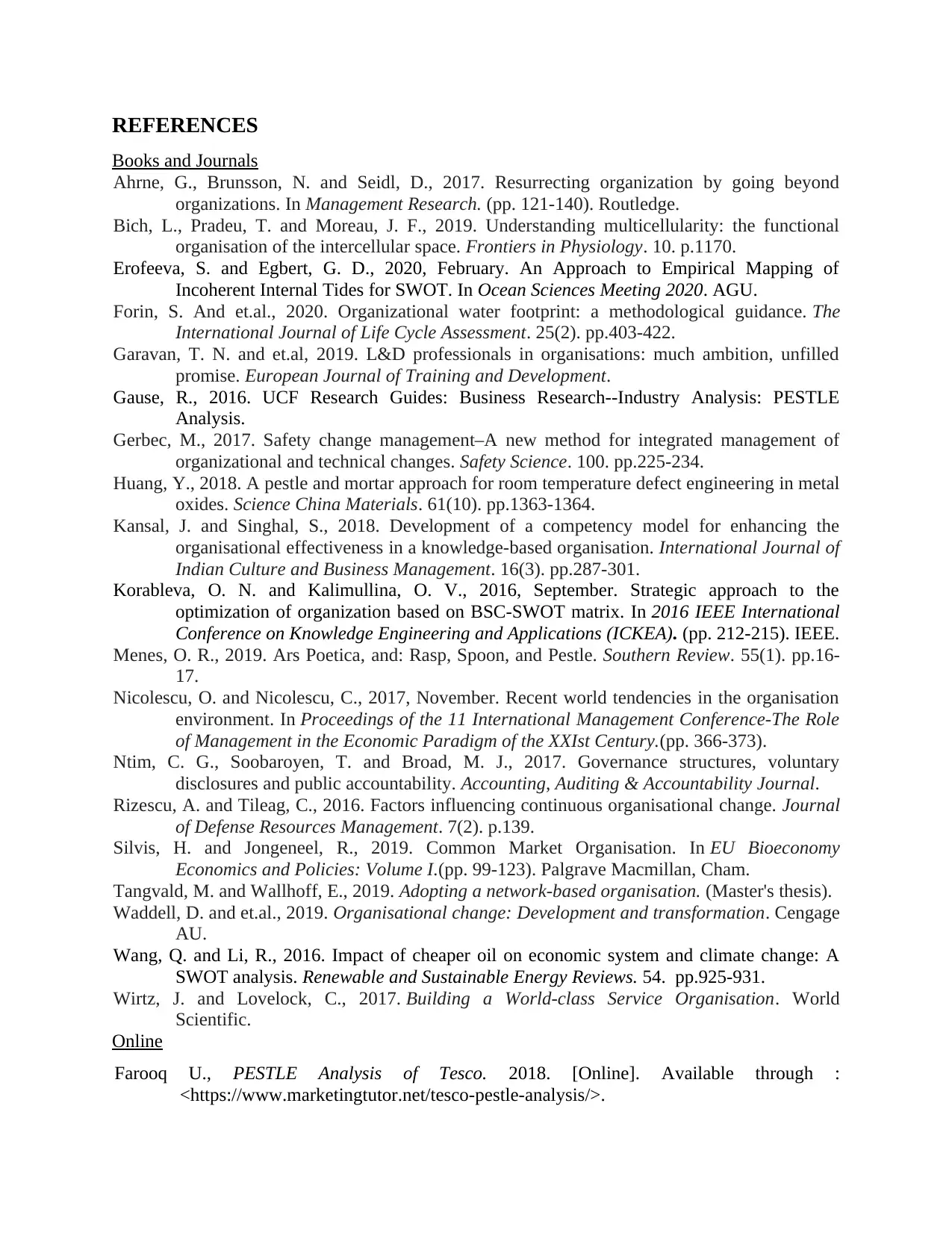
REFERENCES
Books and Journals
Ahrne, G., Brunsson, N. and Seidl, D., 2017. Resurrecting organization by going beyond
organizations. In Management Research. (pp. 121-140). Routledge.
Bich, L., Pradeu, T. and Moreau, J. F., 2019. Understanding multicellularity: the functional
organisation of the intercellular space. Frontiers in Physiology. 10. p.1170.
Erofeeva, S. and Egbert, G. D., 2020, February. An Approach to Empirical Mapping of
Incoherent Internal Tides for SWOT. In Ocean Sciences Meeting 2020. AGU.
Forin, S. And et.al., 2020. Organizational water footprint: a methodological guidance. The
International Journal of Life Cycle Assessment. 25(2). pp.403-422.
Garavan, T. N. and et.al, 2019. L&D professionals in organisations: much ambition, unfilled
promise. European Journal of Training and Development.
Gause, R., 2016. UCF Research Guides: Business Research--Industry Analysis: PESTLE
Analysis.
Gerbec, M., 2017. Safety change management–A new method for integrated management of
organizational and technical changes. Safety Science. 100. pp.225-234.
Huang, Y., 2018. A pestle and mortar approach for room temperature defect engineering in metal
oxides. Science China Materials. 61(10). pp.1363-1364.
Kansal, J. and Singhal, S., 2018. Development of a competency model for enhancing the
organisational effectiveness in a knowledge-based organisation. International Journal of
Indian Culture and Business Management. 16(3). pp.287-301.
Korableva, O. N. and Kalimullina, O. V., 2016, September. Strategic approach to the
optimization of organization based on BSC-SWOT matrix. In 2016 IEEE International
Conference on Knowledge Engineering and Applications (ICKEA). (pp. 212-215). IEEE.
Menes, O. R., 2019. Ars Poetica, and: Rasp, Spoon, and Pestle. Southern Review. 55(1). pp.16-
17.
Nicolescu, O. and Nicolescu, C., 2017, November. Recent world tendencies in the organisation
environment. In Proceedings of the 11 International Management Conference-The Role
of Management in the Economic Paradigm of the XXIst Century.(pp. 366-373).
Ntim, C. G., Soobaroyen, T. and Broad, M. J., 2017. Governance structures, voluntary
disclosures and public accountability. Accounting, Auditing & Accountability Journal.
Rizescu, A. and Tileag, C., 2016. Factors influencing continuous organisational change. Journal
of Defense Resources Management. 7(2). p.139.
Silvis, H. and Jongeneel, R., 2019. Common Market Organisation. In EU Bioeconomy
Economics and Policies: Volume I.(pp. 99-123). Palgrave Macmillan, Cham.
Tangvald, M. and Wallhoff, E., 2019. Adopting a network-based organisation. (Master's thesis).
Waddell, D. and et.al., 2019. Organisational change: Development and transformation. Cengage
AU.
Wang, Q. and Li, R., 2016. Impact of cheaper oil on economic system and climate change: A
SWOT analysis. Renewable and Sustainable Energy Reviews. 54. pp.925-931.
Wirtz, J. and Lovelock, C., 2017. Building a World-class Service Organisation. World
Scientific.
Online
Farooq U., PESTLE Analysis of Tesco. 2018. [Online]. Available through :
<https://www.marketingtutor.net/tesco-pestle-analysis/>.
Books and Journals
Ahrne, G., Brunsson, N. and Seidl, D., 2017. Resurrecting organization by going beyond
organizations. In Management Research. (pp. 121-140). Routledge.
Bich, L., Pradeu, T. and Moreau, J. F., 2019. Understanding multicellularity: the functional
organisation of the intercellular space. Frontiers in Physiology. 10. p.1170.
Erofeeva, S. and Egbert, G. D., 2020, February. An Approach to Empirical Mapping of
Incoherent Internal Tides for SWOT. In Ocean Sciences Meeting 2020. AGU.
Forin, S. And et.al., 2020. Organizational water footprint: a methodological guidance. The
International Journal of Life Cycle Assessment. 25(2). pp.403-422.
Garavan, T. N. and et.al, 2019. L&D professionals in organisations: much ambition, unfilled
promise. European Journal of Training and Development.
Gause, R., 2016. UCF Research Guides: Business Research--Industry Analysis: PESTLE
Analysis.
Gerbec, M., 2017. Safety change management–A new method for integrated management of
organizational and technical changes. Safety Science. 100. pp.225-234.
Huang, Y., 2018. A pestle and mortar approach for room temperature defect engineering in metal
oxides. Science China Materials. 61(10). pp.1363-1364.
Kansal, J. and Singhal, S., 2018. Development of a competency model for enhancing the
organisational effectiveness in a knowledge-based organisation. International Journal of
Indian Culture and Business Management. 16(3). pp.287-301.
Korableva, O. N. and Kalimullina, O. V., 2016, September. Strategic approach to the
optimization of organization based on BSC-SWOT matrix. In 2016 IEEE International
Conference on Knowledge Engineering and Applications (ICKEA). (pp. 212-215). IEEE.
Menes, O. R., 2019. Ars Poetica, and: Rasp, Spoon, and Pestle. Southern Review. 55(1). pp.16-
17.
Nicolescu, O. and Nicolescu, C., 2017, November. Recent world tendencies in the organisation
environment. In Proceedings of the 11 International Management Conference-The Role
of Management in the Economic Paradigm of the XXIst Century.(pp. 366-373).
Ntim, C. G., Soobaroyen, T. and Broad, M. J., 2017. Governance structures, voluntary
disclosures and public accountability. Accounting, Auditing & Accountability Journal.
Rizescu, A. and Tileag, C., 2016. Factors influencing continuous organisational change. Journal
of Defense Resources Management. 7(2). p.139.
Silvis, H. and Jongeneel, R., 2019. Common Market Organisation. In EU Bioeconomy
Economics and Policies: Volume I.(pp. 99-123). Palgrave Macmillan, Cham.
Tangvald, M. and Wallhoff, E., 2019. Adopting a network-based organisation. (Master's thesis).
Waddell, D. and et.al., 2019. Organisational change: Development and transformation. Cengage
AU.
Wang, Q. and Li, R., 2016. Impact of cheaper oil on economic system and climate change: A
SWOT analysis. Renewable and Sustainable Energy Reviews. 54. pp.925-931.
Wirtz, J. and Lovelock, C., 2017. Building a World-class Service Organisation. World
Scientific.
Online
Farooq U., PESTLE Analysis of Tesco. 2018. [Online]. Available through :
<https://www.marketingtutor.net/tesco-pestle-analysis/>.
⊘ This is a preview!⊘
Do you want full access?
Subscribe today to unlock all pages.

Trusted by 1+ million students worldwide
1 out of 15
Related Documents
Your All-in-One AI-Powered Toolkit for Academic Success.
+13062052269
info@desklib.com
Available 24*7 on WhatsApp / Email
![[object Object]](/_next/static/media/star-bottom.7253800d.svg)
Unlock your academic potential
Copyright © 2020–2025 A2Z Services. All Rights Reserved. Developed and managed by ZUCOL.




